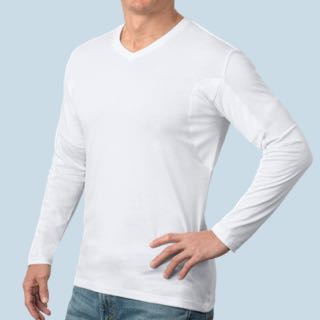Secondary Hyperhidrosis: Causes, Symptoms, Treatments and Prevention
Are you suddenly sweating heavily and don’t know why? Secondary hyperhidrosis may be to blame.
Millions suffer from primary hyperhidrosis, or excessive sweating. However, there is a specialized type of hyperhidrosis called secondary hyperhidrosis (or diaphoresis). Secondary hyperhidrosis originates from a specific source and is potentially reversible.
Today, we’ll take a closer look at the causes and symptoms of secondary hyperhidrosis, plus treatments and prevention tips.
What is Secondary Hyperhidrosis?
Secondary hyperhidrosis, or diaphoresis, causes sweating all over the body. Those with diaphoresis can attribute excessive sweating to a specific underlying cause. According to Mayo Clinic, secondary hyperhidrosis is far less common than primary hyperhidrosis.
Primary hyperhidrosis typically occurs in specific areas of the body like the armpits, hands, face or groin. Individuals with primary hyperhidrosis can experience multiple sweat episodes each day. There is no known cause or cure for primary hyperhidrosis.
Sweating is normal, and everyone sweats differently depending on body temperature or other external factors. But how much you sweat and why is the difference between normal sweating and primary or secondary hyperhidrosis.
Secondary Hyperhidrosis Causes
Causes of secondary hyperhidrosis include medical conditions, hormonal or weight changes, or medication side effects.
If you’re unsure what’s prompting heavy sweating, review these causes of secondary hyperhidrosis.
1. Medical Conditions
Many medical conditions have been linked to excessive sweating, including:
- Anxiety and depression
- Cancer
- Alcoholism
- Obesity
- Heart and lung disease
- Stroke
- Infectious diseases, including tuberculosis and HIV
- Spinal cord injuries
- Parkinson’s disease
- Bacterial infections or fevers
- Allergic reactions
- Withdrawal from alcohol or drug addiction
If you’ve recently been diagnosed with one of these conditions (or could be at risk), your sweating may come with the territory.
2. Pregnancy and Menopause
Hormonal changes that occur during pregnancy and menopause can trigger hot flashes and night sweats. The extra weight of carrying a baby and increased blood flow also contribute to heavy sweating across the entire body.
For pregnant women, excessive sweating only lasts the duration of the pregnancy.
For women going through menopause, the length of secondary hyperhidrosis symptoms varies. Some women experience hot flashes for a few months, while others have them for up to a decade.
3. Medications
Certain drugs can also cause secondary hyperhidrosis. The list of sweat-causing medications includes:
- Antidepressants
- Aspirin and nonsteroidal anti-inflammatory drugs (NSAIDs)
- Antibiotics
- Pain medications
- Blood pressure medications
- Cancer treatments
- Diabetes medications
- Hormone treatments
Even common dietary supplements can cause excessive sweating. These include:
- Zinc supplements
- Iron supplements
4. Weight Gain
If you’ve recently gained weight, you may sweat more profusely. Fat insulates the body, raising its core temperature.
A higher body temperature means your body needs to sweat more to cool down. Plus, it’s more challenging to move around with higher body weight - the increased effort taxes circulation, generating internal heat.
The larger you are, the more heat your body creates and the more likely you are to sweat excessively. Keeping your body weight within normal ranges will help your body stay cooler and drier.
Secondary Hyperhidrosis Symptoms
Here are some indicators and signs that you may have secondary hyperhidrosis:
- Your symptoms started after age 25, and you haven’t experienced unusual or excessive sweating previously.
- Heavy sweating doesn't run in your family.
- You recently started taking a medication listed above or were diagnosed with a medical condition that may cause sweating.
- Sweating occurs everywhere, not just in one particular area.
- You also experience flu-like symptoms such as fatigue and headaches.
- You sweat excessively when sleeping.
- You are approaching the age of menopause or may be pregnant.
Seek immediate medical attention if you experience excessive sweating with any of the following symptoms, which may be signs of a more life-threatening condition:
- chest pain or heart palpitations
- cold, clammy skin
- loss of consciousness or dizziness
- nausea or vomiting
- pale skin color
- seizures
- trouble breathing.
Secondary Hyperhidrosis Treatments
Can your heavy sweating be reversed? Yes, as long as you resolve the underlying health conditions causing your sweating.
Important: If an essential medication is inducing your heavy sweating, alternative remedies are necessary. Forgoing certain medications can pose significant health risks. Consult your doctor before making any health-related decisions.
Profuse sweating can be quite embarrassing and inconvenient, but once you determine what kind of sweat you’re experiencing, you can take steps to manage it.
Here’s what we recommend for secondary hyperhidrosis treatments.
1. Clinical-Strength Antiperspirant
Your doctor may prescribe antiperspirants to control your sweating. The most effective antiperspirants contain 10 to 15 percent aluminum chloride, which effectively plugs your sweat glands.
2. Anticholinergic Medications
Anticholinergic medications block certain neurotransmitters that affect how your body functions. Anticholinergics are available in tablet and cream forms.
Anticholinergics are prescribed for “off-label” use to help profuse, all-over sweating. “Off-label” means that a drug has been approved by the FDA for a specific medical use, but is effective for other conditions.
Be sure to tell your doctor about other medications you’re currently taking, as anticholinergics may not work for everyone who sweats excessively.
3. Sweat Proof Clothing
Updating your wardrobe with sweat proof undershirts or colors that don’t show sweat is an effective, toxin-free solution for those who sweat heavily.
To protect the clothing you already own, wear a sweat proof Thompson Tee to prevent wet marks and stains from ruining your outer layers. The founders of the Thompson Tee, who both have hyperhidrosis, created their best-selling sweat proof undershirts for men and women.
Thompson Tees’ patented Hydro-Shield sweat proof technology has helped thousands of individuals manage excessive underarm sweating and reclaim their confidence.
If you're searching for a solution to heavy underarm sweating, we encourage you to try a sweat proof undershirt risk-free and experience the difference yourself!
*PLEASE NOTE: As with any medical-related issues, it's best to seek advice from a qualified medical practitioner. The information provided is not to be relied on for any diagnostic purposes and should not be used as a substitute for professional diagnosis and treatment.


